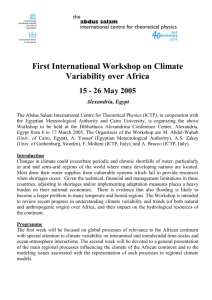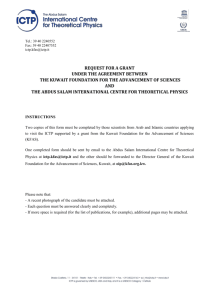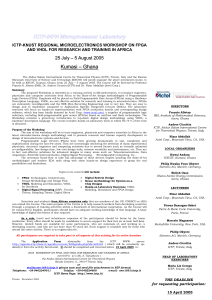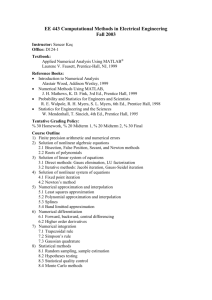1848_T25_Ferreri - Indico
advertisement
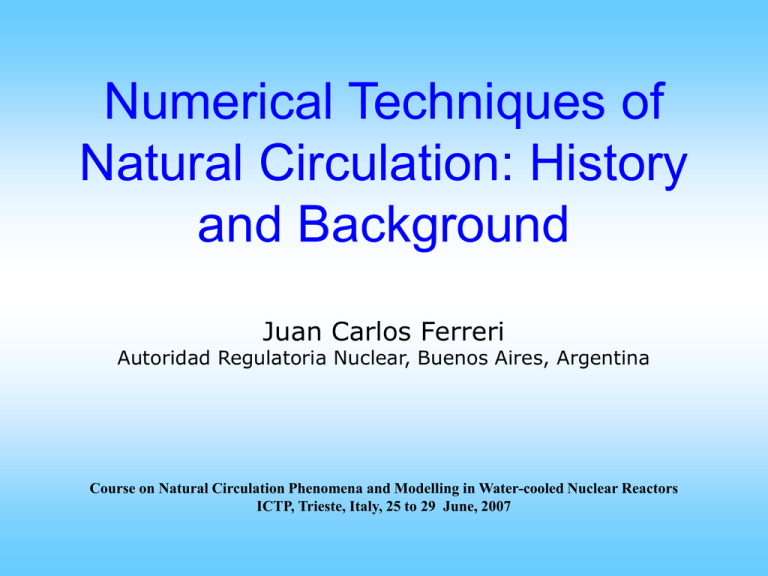
Numerical Techniques of
Natural Circulation: History
and Background
Juan Carlos Ferreri
Autoridad Regulatoria Nuclear, Buenos Aires, Argentina
Course on Natural Circulation Phenomena and Modelling in Water-cooled Nuclear Reactors
ICTP, Trieste, Italy, 25 to 29 June, 2007
ICTP, 2007
CONTENTS
Purpose of this presentation and introductory
remarks
On numerical methods
A brief review of present status of CFD in
relation to natural circulation, best practices
and other issues
Conclusions
2
ICTP, 2007
This presentation is aimed at considering several aspects of Numerical
Techniques giving the background to the computation of Fluid
Dynamics as applied to the Computational Fluid Dynamics (CFD) of
Natural Circulation (NC). It will be shown that:
a. There is plenty of consolidated literature and concepts on numerical
methods since 50 years ago.
b. CFD is not a new activity in relation to NC and the thermal hydraulics of
Nuclear Safety
c. Many outstanding people contributed to this subject in the last five
decades
PURPOSE OF THIS PRESENTATION
3
ICTP, 2007
d. The present boom of CFD activity in NC and on separate effects in
nuclear installations is a consequence of the needs of a
re-emerging activity
e. Nuclear Safety benefits from well developed techniques in other
areas of computational mechanics
f. Although some spectacular CFD results may be found at TH fora
and in open (www) sources, not so many are already published in
regular journals.
g. Most publications deal with the needs and challenges posed by the
physics and with clarifying the degree of detail required by nuclear
safety
PURPOSE OF THIS PRESENTATION
4
ICTP, 2007
Two possible definitions in this context:
• A numerical technique is an incremental (or
discrete) way of representing a differential
equation (that is part of a physical model in NC)
• Computational Fluid Dynamics is a discipline
that allows solving conservation equations using
adequate discrete representations at a desired
level of resolution, implying more than a
numerical technique
INTRODUCTORY REMARKS
5
ICTP, 2007
On pioneers…
Obviously, numerical techniques applications are not a new activity in
relation to the thermal hydraulics of all the flow stages of transients in
nuclear installations (NC among others).
In my view, it was the work at Los Alamos Scientific
Laboratory which (now more than 30 years ago), in those
days of “open” exchange of scientific information, opened the
way to “widespread” numerical modeling in fluid dynamics.
See, e.g.:
Los Alamos Science, vol. 2, no. 2, summer/fall 1981
summarizing work done up to that year at LANL
INTRODUCTORY REMARKS
6
ICTP, 2007
People, people…
Many outstanding people contributed to this activity in the last 50 years...
However, again in my view, LANL pioneered in this subject and
its most relevant people were:
Francis H. Harlow, J. Fromm, C.W. Hirt, D.L. Liles,
J. Mahaffy, A.A. Amsdem, J.R. Travis, J.P. Shanon, J. Pryor
and B.J. Daly, among others.
Perhaps you have heard about codes like PIC, SOLA, SOLASURF, SOLA-DF, SOLA-VOF, SALE-3D, SOLALOOP, K-FIX,
etc. (see J.Comp. Physics)
P. Roache gave also an important and comprehensive review and
recommendations on numerical techniques and CFD by 1972.
People at LLNL also contributed significantly
INTRODUCTORY REMARKS
7
ICTP, 2007
People, people…
Other people pioneered in Europe, like
B. Spalding, M. Wolfshtein, S. Patankar at Imperial
College, R. Peiret at ONERA and many others.
I will just mention some people that contributed to the
development from the numerical analysis side...
…because the list is too long, but the names of R. Courant,
K.O. Friedrichs, D. Hilbert, J. von Neumann, P.D. Lax,
R.D. Richtmyer, G.I. Marchuk (in Russia) and W.F. Ames
should, at least, be mentioned.
INTRODUCTORY REMARKS
8
ICTP, 2007
People, people…
The Drift-Flux theory of two-phase flow, as developed by
Zuber and Findlay and by M. Ishii in his book, was the
physical two-phase fluid model that allowed generating
results of Nuclear Safety significance through its
implementation in the TRAC code and other hydrodynamics
codes at LASL.
Many other people contributed significantly in this field, like
J.M. Delhaye, R. Lahey, M. Giot, F.H Moody, G.B. Wallis,
R.E. Henry, J.A. Bouré, D.C. Groeneveld, G. Yadigaroglu
and simply too many others to be cited here…
INTRODUCTORY REMARKS
9
ICTP, 2007
An appropriate conceptual excerpt…
• “In as much as we can simulate reality, we can use the computer to
make predictions about what will occur in a certain set of
circumstances.
• Finite-difference techniques can create an artificial laboratory for
examining situations which would be impossible to observe otherwise,
but we must always remain critical of our results.
• Finite-differencing can be an extremely powerful tool, but only when it is
firmly set in a basis of physical meaning. In order for a finite-difference
code to be successful, we must start from the beginning, dealing with
simple cases and examining our logic each step of the way.”
Reference: E. Scannapieco and Francis H. Harlow, Introduction to Finite-Difference
Methods for Numerical Fluid Dynamics, LA 12984, issued 1995
INTRODUCTORY REMARKS
10
ICTP, 2007
Some examples
i.e. 13500 computing cells
code: SALE-3D
“Detailed studies of reactor components”, A.A. Amsdem et al., Los Alamos Science, 1981, pp. 54-73
INTRODUCTORY REMARKS
11
ICTP, 2007
Some examples
With far more modest resources we were working too…
1331 fluid computing cells
code: a SOLA 3D like…
B. Martinez and J.C. Ferreri, Lat. American J. of Heat and Mass Transfer, vol. 6, pp. 1-12, 1982
and other references before…
INTRODUCTORY REMARKS
12
A proposal for what follows…
ICTP, 2007
Understanding the need of making efforts
in the appropriate modelling of 1D flows
fluid dynamics
(this seems a somewhat old-fashioned
proposal at this time, when multidimensional CFD modelling governs the
trends in the analysis of NC and separate
effects in Nuclear Safety related issues)
However, let´s make...
INTRODUCTORY REMARKS
13
ICTP, 2007
A small digression on scaling laws…
For single-phase flows in vertical pipes (or two-phase flows with equal velocities and
temperature), the effects of each term in the conservation equations are preserved in model
and prototype without any distortion, if one imposes the requirements of:
a) Same fluid at equal pressure, properties and enthalpy:
b) Isochronous phenomena:
pP P h P
1
pM M h M
tP 1
tM
They lead to the Power to Volume scaling relations, i.e.:
P WP V P m
M WM V M
Where m is chosen on the basis of available resources, usually power for the model
Reference: N. Zuber, "Problems in Modeling of Small Break LOCA", NUREG-0724, 1980
INTRODUCTORY REMARKS
14
ICTP, 2007
A small digression on scaling laws…
c) Imposing now equal elevations:
lP 1
lM
(This condition is essential to keep equal gravity driving forces, i.e. in the case of
Natural Circulation flows).
Then,
together with the Power to Volume relations, m SPECIFIES m as the ratio of cross sections. It
also implies that velocities ARE equal.
d) Furthermore, frictional effects are equal if:
K
AC P
1
K
AC M
INTRODUCTORY REMARKS
15
ICTP, 2007
A small digression on scaling laws…
The cause of 30 years delay to 2D/3D?
From: General Description of the PACTEL Test Facility
(VTT/TM/RN-1929, 1998)
Simulates a VVER-440 PWR in Lovisa, Finland
Volumetric scaling 1:305 – Height 1:1 – Loops 3:6
Fuel diameter 1:1 - Power 1 MW
INTRODUCTORY REMARKS
16
ICTP, 2007
A small digression on scaling laws…
May be because (in my view)...
a) scaling laws “force” to almost 1D integral representations of real life
installations, with pre-established flow patterns
b) a huge effort was focused on the development of a representative
physical data base (amenable to 1D analysis) and separate effects on the
other side (like plume analysis, non-symmetric flow distribution,
particular aspects of reactor components behavior, etc.) affordable
through detailed computational techniques
c) code assessment for safety analysis also imposed a great effort for 1D
INTRODUCTORY REMARKS
17
ICTP, 2007
A small digression on scaling laws…
...because (in my view)... Cont´d.
d) time scales to solve problems in realistic way (as a compromise between
cell Courant number limitation for fast transients using semi-implicit
methods and time inaccuracies, i.e. damping, for implicit methods)
impose large number of time steps to span long time transients (e.g. in
SBLOCAs)
e) ill posedness of the governing equations “precluded” (for some people)
search for detailed convergence of solutions, leading to coarse grid
computations and stabilization of flow solvers by numerical means
f) computers were not fast, cheap and widely available and not too many
were interested in paying for detailed analyses, neither were asking
too much for them…
INTRODUCTORY REMARKS
18
ICTP, 2007
A small digression on scaling laws
...because (in my view) Cont´d.
“Sometimes, scaling leads to the adoption of the 1-D approximation; this
may, in turn, hide important aspects of the system physics. A simple
example of this situation consists in keeping the height of the system
unchanged to get the same buoyancy; then, if the system is scaled
accordingly to the power/volume ratio, the cross section area of the volume
will be reduced; this leads to a much smaller pipe diameter that makes the
1-D representation reasonable, at the cost of eliminating the possibility of
fluid internal recirculation”
“A workaround for this situation is providing paths for recirculation, in
the form of additional, interconnected components; however, this solution
may impose the flow pattern in the system and the balance between these
aspects is a challenge to any practitioner in natural circulation modeling”
REFERENCE: On the analysis of thermal-fluid-dynamic instabilities via numerical discretization of
conservation equations, J.C. Ferreri, W. Ambrosini, NED, 215, 153–170, 2002
INTRODUCTORY REMARKS
19
ICTP, 2007
A small digression on scaling laws…
However (I believe)...
1D, thermal hydraulics system codes will be used at least
for a decade or more, coupled with 3D modules for the core
and/or for some specific components where separate effects
analysis is the goal.
Then, in the following slides, some basic aspects of
numerical techniques as applied to simple 1D problems
of physical significance will be reviewed
To start with, an exact, discrete approximation of a
conservation like evolution equation will be developed
INTRODUCTORY REMARKS
20
The balance equations
ICTP, 2007
Possible Restrictions
Velocity
Homogeneous
Slip ratio
Drift flux
Temperature or Enthalpy
Equilibrium (Saturation)
Partial Equilibrium
Two-Phase Fluid Models
Thermodynamic
Properties
Numerics
Typical Two-Phase Fluid
Balance Equations
6-Equation Model
5-Equation Models
4-Equation Models
3-Equation Models
Types of Constitutive Equations
(Flow Regime Dependent)
Wall Friction (phase or mixture)
correlations
Wall Heat Transfer (phase or mixture)
correlations
Interfacial Mass Transport Equation
Interfacial Momentum Transport
Equation
Interfacial Energy Transport Equation
Two-Fluid Non-Equilibrium
Balance Equations (6-Equations)
(2) Mass Conservation Equations
(2) Momentum Conservation Equations
(2) Energy Conservation Equations
Two-Phase Fluid Model
Calculated Parameters
6-Equation:
, p, vl , vv , Tl , Tv
5-Equation:
, p, Tl , Tv , vm
, p, vl , vv , Tl or Tv
4-Equation:
3-Equation:
, p, vl , vv
, p, vm , Tv or Tl
, p, vm
REFERENCE as provided: “Governing equations in two-phase fluid Natural circulation flows”,
J.N. Reyes, jr, IAEA TECDOC 1474, 155-172, 2005
INTRODUCTORY REMARKS
21
ICTP, 2007
Numerical approximations of conservation equations
Let us consider the following evolution equation, depending on time t and space
x, where L is a linear operator.
u
k
L (t, x,
) u , k 1, K
k
t
x
u is the dependent variable. It may be expanded in Taylor series around t+t
1 u
1 2u 2
u(t t, x) u(t, x)
t
t HOT
2
1! t
2! t
Where HOT means terms of higher order. This equation may be formally written
as:
u (t t ) exp(t )u(t, x) exp(t L) u(t, x)
t
Which is an explicit approximation to the evolution differential equation
ON NUMERICAL METHODS
22
ICTP, 2007
Numerical approximations of conservation equations
By pre/post multiplying by suitable operators, implicit approximations may be
obtained, like Crank Nicholson or fully implicit, as follows:
t
t
exp( L) u(t t ) exp( L) u(t, x)
2
2
exp(t L) u(t t ) u(t, x)
If L is a 3D operator, i.e. L = L1 + L2 + L3, the corresponding fully implicit
approximation is:
exp( t L1 ) exp( t L 2 ) exp( t L3) u ( t t ) u ( t , x )
ON NUMERICAL METHODS
23
ICTP, 2007
Numerical approximations of conservation equations
Introducing intermediate definitions for u (they are not necessarily intermediate
time approximations) then:
exp( t L1 ) u * u ( t , x )
exp( t L 2 ) u ** u *
exp( t L 3 ) u ( t t ) u **
That is a sequence of 1D problems, known as an Aternating Direction Implicit
method when L1, L2 and L3 depend on each space coordinate.
Now, the discrete approximation in space will be introduced. It is:
1
1 u x 1 2 u x 2
u(x x) u(x)
2
2
1! x 2 2! x
4
ON NUMERICAL METHODS
24
ICTP, 2007
Numerical approximations of conservation equations
Introducing a centered difference operator, defined as:
1
1
u (x) u(x x) - u(x x)
2
2
Then,
u 2
1
1 x
sinh ( )u i
( x HOT)u i
x x
2
x
Finally:
2
2
2
u in 1 expt L i x, n t ,
sinh 1 ( x ),
sinh 1 ( x ) , u in
x
2 x
2
ON NUMERICAL METHODS
25
ICTP, 2007
Numerical approximations of conservation equations
THE PREVIOUS EQUATION IS AN EXACT DISCRETE
REPRESENTATION OF THE EVOLUTION EQUATION
In this form it is not useful for working
All practical approximation come from truncation of the series
This, in turn, implies the appearance of the truncation error of
the approximation.
Postulate:
TRUNCATION ERROR IS NOT A DISGRACE
Its adequate treatment allows the construction of useful working
techniques.
ON NUMERICAL METHODS
26
Three necessary definitions…
ICTP, 2007
CONSISTENCY
Given a dependent variable that is sufficiently differentiable in a domain D and its
boundary R, then, if an appropriate norm of the truncation errors L - Lh and B - Bh
tend to zero when the increments of the independent variables tend to zero in some
way, then the discrete scheme Lh, Bh is said consistent with the differential
operators L, B
STABILITY
Given a function U defined in all the points of a grid in D and its boundary R,
then, if exists a finite quantity K such that in an appropriate norm, it is
U K { Lh (U) Bh (U) }
for all the functions U defined in D+R, then the discrete scheme is said stable
Consistency and Stability may be conditional
ON NUMERICAL METHODS
27
Three necessary definitions
ICTP, 2007
CONVERGENCE
Given a function U defined in all the points P of a grid in D and its boundary R,
then, considering linear operators, if the discrete scheme is consistent and stable,
then the discrete scheme is convergent, i.e.:
u (P) U(P) tends to zero
This is the equivalence theorem of P. Lax that allows constructing
discrete, convergent solutions of a differential problem.
ON NUMERICAL METHODS
28
ICTP, 2007
EXAMPLES
Pure, 1D diffusion equation:
u
2u
t
x 2
Truncating to O(t, x2) it is:
2
2 n
ui
4
n 1
n
n
x
x
u i t 1 t
u i u i t
2 4
2
x
x
Finally, the 1st order in time, Euler´s approximation is obtained:
u in 1 u in
2x u in
t
x 2
ON NUMERICAL METHODS
This scheme is conditionally stable
29
ICTP, 2007
EXAMPLES
Linear, 1D scalar advection-diffusion equation
u
u
2u
C
t
x
x 2
Approximating by centered differences, it is:
u in 1 u in
u in1 u in1
2x u in
C
;
2
t
2x
x
C0
After expanding in Taylor series and keeping second order terms, it follows that:
u t 2 u
u
2u
C
O(t 2 , x 2 )
t
2 t 2
x
x 2
Reference: Heuristic Stability Theory for FDE, C.W. Hirt, J. Comp. Phys., 2, pp. 339-355, 1968
ON NUMERICAL METHODS
30
ICTP, 2007
EXAMPLES
The previous expression is an hyperbolic differential equation and, in order
that its domain of influence is to be contained in the domain of influence of the
difference equation.
A necessary condition is that:
2
t
x
t
2
Coming back to the expanded difference equation and introducing the original
differential equation, it follows that:
2
u
u
2 t u
C
( C )
O(t 2 , x 2 )
t
x
2 x 2
The previous expression clearly imposes:
ON NUMERICAL METHODS
t
C 0
2
2
31
ICTP, 2007
EXAMPLES
Let us now consider the scalar advection equation, i.e. = 0
u
u
C
0
t
x
and consider the following approximation:
u in 1 u in
u in u in1
C
;
t
x
C0
Proceeding as above, it is:
u
u
C x C 2 t 2 u
C
(
)
O(t 2 , x 2 )
t
x
2
2
x 2
that is a parabolic equation.
ON NUMERICAL METHODS
32
EXAMPLES
ICTP, 2007
that leads to
C t x
or
C t / x 1
The expression above implies that the fluid can span at most a cell length in a
time interval to keep calculation stable.
The cell Courant number is defined as:
C t
Co
x
and must be less (or equal to be strict) than unity.
In advection dominated problems, it is usually taken as 0.8
ON NUMERICAL METHODS
33
ICTP, 2007
EXAMPLES
The non centered expression introduced is called an upwind approximation of
the advection term and generates artificial or numerical diffusion that in the case
of the transport of sharp waveforms or shock waves, smoothes the solution
making it computable (the last concept was introduced by von Newman and
Richtmyer in 1950)
In conjunction with the explicit time approximation constitutes the “Forward
time, upwind space” approximation to the scalar wave equation or FTUS
method.
This is the usual approximation used in the CFD codes to stabilize calculations or
to regularize ill-posed models like in RELAP5, through the introduction of numerical
diffusion. Many other methods have been developed with this philosophy.
Adequate discretization permits keeping low truncation error and allowing the
computation of unstable flows.
Reference: “A Method for the Numerical calculation of Hydrodynamic Shocks”, J. von
Neumann and R.D. Richtmyer, J. Applied Phys., 31, pp. 232-237, 1950
ON NUMERICAL METHODS
34
ICTP, 2007
Managing truncation error to linearize governing eqns.
It was asserted that truncation error is not a disgrace. In what follows this will
be justified, simply by showing how use this concept to linearize Burger´s like
operators. Let:
u
L1 u Nu 0
t
be the equation under analysis, where L1 is a linear operator and N is a nonlinear operator. Let us assume that N is restricted to the form:
Nu L2 u Au
where L2(u) is linear in u and A is such that the algebraic problem resulting
from the discrete approximation of the previous equations is also linear.
Burger's equation is a useful example; in this case:
2
A u, L1 2 , L 2
x
x
ON NUMERICAL METHODS
35
ICTP, 2007
Managing truncation error to linearize governing eqns.
A Crank-Nicholson approximation may be written as:
t *
t *
t
n 1 t
n
I
L
A
L
U
I
L
A
L
1
2
1
2 U
2
2
2
2
where I is the identity operator and A* is a matrix independent of time and a
suitable approximation to A to be defined in what follows.
Expanding this expression in a Taylor series around n, we get:
u t 2 2 u
u t
2
t
2 t
L
t
t
t L
L1 A * L 2 t 1 A * 2
2
2
2 t
t
t
t
u L1 A * L 2 O t 3 ,
2
2
ON NUMERICAL METHODS
36
ICTP, 2007
Managing truncation error to linearize governing eqns.
Then,
u t 2 u
t L1
*
* L 2
2
L
A
L
A
O
t
1
2
t 2 t 2
2 t
t
but, from the original equation:
2u
L1 A L 2
2
t
t
t
Then, it follows that:
u
t L 2 t A L 2
*
2
L1 A L 2
O
t
t
2 t 2
t
ON NUMERICAL METHODS
37
Managing truncation error to linearize governing eqns.
ICTP, 2007
In order to obtain an estimation for we now ask: under which conditions is this
equation an "exact", i.e., an O(t2) approximation to the solution of the original
equation? The answer comes from subtracting the previous equation equation
from the original one:
t L
t A L 2
A * L 2 2 A L 2
0
2 t
2
t
This expression is equivalent to:
A* L 2 u n
1
2
Au L u
n 12
n 12
2
Finally, after postmultiplying by L21 u n
*
A Au
1
2
and adopting
n 12
we obtain the “exact” [i.e. O(t2) ] solution.
ON NUMERICAL METHODS
38
ICTP, 2007
Managing truncation error to linearize governing eqns.
Because of the CN formulation, terms involving additional diffusion terms
do not arise. If A* is evaluated as shown, then, the technique coincides
with a predictor-corrector scheme based on the evaluation of "non-linear"
coefficients evaluated at
t t n n 12 t
This result is well known.
As may be observed from the above derivation, truncation error
may be used, again, in a convenient way
ON NUMERICAL METHODS
39
ICTP, 2007
A visualization of truncation error effects
10
Dimensionless Flow
(Q) =
Q s
Q t
1
2
s
5
0
1000 Nodes
-5
500 Modes +
D(1000)
-10
0
10
5
15
Dimensionless Time
The flow rate for the FTUS scheme in a simple loop in unstable NC flow using 1000 nodes and
its simulation using a modal expansion of 500 modes and added numerical diffusion
These aspects will deserve further discussion in the second presentation
ON NUMERICAL METHODS
40
ICTP, 2007
There is more than truncation error… 1/5
Group velocity governs the transport of energy when the governing
equations are dispersive, i.e. equations that admit solutions of the form:
exp(t x )
but with the property that the speed of propagation of the waves are dependent of
. In this expression is the wave number and is the angular wave frequency.
If is the wave length, the resolution is defined as m=/x
The group velocity is defined as:
d
CG
d
Additionally, by definition: = m
REFERENCE: Group Velocity in Finite Difference Schemes, L.N. Threfethen, SIAM Review, 24, 113-135, 1982
ON NUMERICAL METHODS
41
ICTP, 2007
There is more than truncation error… 2/5
It is obtained replacing by in the discrete equations each expression of U by:
U in11 e j ( x x ) ( t t )
…as an example.
and is a function of the resolution m and the cell Courant number CO
The numerical scheme to illustrate this property is the LEAPFROG scheme,
as applied to the linear scalar wave equation, one of the simplest numerical
schemes, of order O(2,2) and defined by:
u in 1 u in 1
u in1 u in1
C
2 t
2 x
ON NUMERICAL METHODS
42
ICTP, 2007
There is more than truncation error… 3/5
Then:
CG
1 Co2 2
1
C
2
The illustration considers the LINEAR ADVECTION OF A SCALAR
with two different wave forms, namely a smooth Gaussian and a wave
packet.
In both cases, the transport velocity is C = 1, the space interval is
Δx = 1/160, the Courant number is CO = 0.4, the resolution is m = 8 and
the total time of integration is t = 2.
With the above parameters, the group velocity is 0.74
ON NUMERICAL METHODS
43
There is more than truncation error… 4/5
ICTP, 2007
A smooth gaussian perturbation…
LEAPFROG SCHEME
U=1, C=0.4, 0<t<2, Cg=0.74
1
0.8
0.6
0.4
0.2
C
0
-0.2
-0.4
-0.6
-0.8
-1
0.0
0.5
1.0
1.5
2.0
2.5
3.0
X
ON NUMERICAL METHODS
44
There is more than truncation error… 5/5
ICTP, 2007
A wave packet perturbation…
LEAPFROG SCHEME
U=1, C=0.4, Wave-No=125.7, Res=8, 0<t<2, Cg=0.74
1
0.8
0.6
0.4
0.2
C
0
-0.2
-0.4
-0.6
-0.8
-1
0.0
0.5
1.0
1.5
2.0
2.5
3.0
X
ON NUMERICAL METHODS
45
ICTP, 2007
On using CFD for NC calculations
Why it is worth considering CFD approaches for CN, even in
simple cases…
…through an example of how using well established,
“natural” 1D laws in 1D TH loops to get non-conservative,
wrong results
Let us consider the NC flow in a simple TH loop in
unstable flow conditions
ON NUMERICAL METHODS
46
ICTP, 2007
On using CFD for NC calculations
Natural Circulation in a simple TH loop
W. Ambrosini, N. Forgione, J.C. Ferreri and M. Bucci, A. Nuc Energy, 31, pp. 1833–1865, 2004
ON NUMERICAL METHODS
47
ICTP, 2007
ON NUMERICAL METHODS
On using CFD for NC calculations
48
On using CFD for NC calculations
ICTP, 2007
0.0232 m I.D. Loop of Vijayan et al. (1995)
1st Order Scheme, Fine Nodalisation, Dt = 0.1 s, Friction law suggested by Vijayan et al.
1000
900
Heater Power [W]
800
700
ALWAYS UNSTABLE
600
500
400
300
200
100
25
26
27
28
29
30
31
32
33
34
35
Secondary Coolant Temperature [°C]
ON NUMERICAL METHODS
49
On using CFD for NC calculations
ICTP, 2007
0.0232 m I.D. Loop of Vijayan et al. (1995)
1st Order Scheme, Fine Nodalisation, Dt = 0.1 s, Churchill's Friction Law
1000
900
Heater Power [W]
800
UNSTABLE
700
600
500
400
STABLE
STABLE
300
UNSTABLE
200
100
25
26
27
28
29
30
31
32
33
34
35
Secondary Coolant Temperature [°C]
ON NUMERICAL METHODS
50
ICTP, 2007
On using CFD for NC calculations
What if we go to a CFD approach for this simple problem?
CODE: FLUENT 6.0
CELL No.: about 50000
CPU time to span 1000 s:
three days on a standard PC
Using RELAP5:
CPU time to span 1000 s:
some minutes on the same PC
PS: no macroscopic friction law are used by FLUENT in this case...
ON NUMERICAL METHODS
51
ICTP, 2007
On using CFD for NC calculations
Onset of unstable flow:
captured due to stratification allowed by detailed CFD approximation
ON NUMERICAL METHODS
52
ICTP, 2007
ON NUMERICAL METHODS
On using CFD for NC calculations
53
ICTP, 2007
On using CFD for NC calculations
Some collaborative efforts to elucidate the needs on CFD in relation to
Nuclear Safety evaluations
Evaluation of CFD methods for reactor safety analysis - ECORA (12 partner institutions, see M. Scheuerer el al., NED, vol. 235,
pp. 359-368, 2005)
• To show to end-users, utilities and regulators to which extent CFD can
enhance the accuracy of safety analysis implies “addressing the lack of
certainty on CFD results and defining related Best Practice Guidelines to
evaluate these results”
ON THE PRESENT STATUS OF CFD IN RELATION TO NUCLEAR SAFETY
54
ICTP, 2007
On using CFD for NC calculations
Objectives reached, according to authors:
• The establishment of BPGs for ensuring high-quality results and for the
formalized judgment of CFD calculations and experimental data.
• The assessment of the potential, and of current limitations of CFD methods for
flows in the primary system and in LWR containments, with special emphasis on
PTS.
• The definition of experimental requirements for the verification and validation
of CFD software for flows in the primary system and in LWR containments.
• The identification of improvements and extensions to the current CFD packages that
are necessary for primary loop and containment flow analysis.
• The implementation and validation of improved turbulence and two-phase flow
models for the simulation of PTS phenomena in PWR primary systems.
From M. Scheuerer el al., NED, vol. 235, pp. 359-368, 2005
ON THE PRESENT STATUS OF CFD IN RELATION TO NUCLEAR SAFETY
55
ICTP, 2007
On using CFD for NC calculations
The BPGs are documented in Menter (2002). They contain detailed information on:
• The formalized judgement of results obtained with different CFD software
packages. This includes the definition and quantification of round-off, iteration,
and discretisation errors, and the assessment of modelling errors.
• The consistent use of CFD methods for reactor safety problems. These guidelines
relate to geometry and grid generation, boundary and initial condition
specification, selection of suitable physical models, and handling of solution
algorithms.
• The judgement of experiments regarding their use for verification and validation
of CFD methods.
The guidelines include criteria for checking global mass, momentum, and energy
balances, consistency checks for field data, and plausibility checks. Experiments are
grouped in a hierarchy ranging from laboratory studies to industrial field tests.
The BPG report is intended as a living document.
REFERENCE: M. Scheuerer el al., NED, 235, pp. 359-368, 2005
F. Menter, EVOL - ECORA - D01, 2002
ON BEST PRACTICES AND OTHER ISSUES…
56
ICTP, 2007
On wiggles and oscillations of the solutions
The 1-D advection-diffusion equation
solution for different Peclet numbers.
Points indicate the EXACT, STABLE
solution using centered differences.
The oscillating one is due to non
appropriate boundary layer
resolution. Asymptotic analysis or,
more simply, introduction of
upwinding eliminates the problem
Reference: A note on the Advection-Diffusion Equation, J.C. Ferreri, IJNMF, 5, pp.593-596, 1985
ON BEST PRACTICES AND OTHER ISSUES…
57
ICTP, 2007
On wiggles and oscillations of the solutions
Non-linear coupling, Navier-Stokes eqns.
NO UPWINDING
Non-linear coupling, Navier-Stokes eqns.
NO UPWINDING - Halved time interval
Reference: Heuristic Stability Theory for FDE, C.W. Hirt, J. Comp. Phys., 2, pp. 339-355, 1968
ON BEST PRACTICES AND OTHER ISSUES…
58
ICTP, 2007
On wiggles and oscillations of the solutions
The existence of spurious oscillations in the solution of
conservation equations may be the consequence of non appropriate
resolution of the boundary layer behavior of the solution.
Then, suppressing the oscillations may be non conservative or,
equivalently, allow computing a solution not showing all the
important aspects of the physics. Work done in the 80´s served to
clarify this aspects.
P. Gresho at the LLNL and at IJNMF contributed significantly
to this subject.
Reference: Don´t suppress the wiggles, they are telling you something, P. Gresho and R. Lee,
Comp. and Fluids, 12,223-231, 1981
ON BEST PRACTICES AND OTHER ISSUES…
59
ICTP, 2007
On using BFC´s for Heat Transfer Calculations
On the accuracy of boundary fitted calculations, J.C. Ferreri and M. Ventura, IJNMF, 4, pp. 359-375, 1984
ON BEST PRACTICES AND OTHER ISSUES…
60
ICTP, 2007
On using BFC´s for Heat Transfer Calculations
ON BEST PRACTICES AND OTHER ISSUES…
61
ICTP, 2007
On using BFC´s for Heat Transfer Calculations
It is simple to demonstrate that in the case of
uniform heating, constant surface
temperature can only be obtained using
regularly spaced grids at he surface and
nearby interior (see the effect of Biot number)
ON BEST PRACTICES AND OTHER ISSUES…
62
ICTP, 2007
On using BFC´s for Navier-Stokes Calculations
ON BEST PRACTICES AND OTHER ISSUES…
63
ICTP, 2007
On using BFC´s for Navier-Stokes Calculations
ON BEST PRACTICES AND OTHER ISSUES…
64
ICTP, 2007
Some preliminary conclusions…
The use of adaptive grids must be exercised with care. Even 1D cases
may reflect the type of problems shown when the boundary conditions
are of mixed (Robin) type.
The use of norms to get an insight of convergence of the solution should
also be applied with care, because the solution may be almost perfect,
but delayed or advanced in time depending on the scheme and its group
velocity.
Oscillations in a computed solutions may be an indication of non
appropriate discretization. Forcing its elimination may be a cause of
losing information on the physics but, at the same time, making
possible the calculation.
ON BEST PRACTICES AND OTHER ISSUES…
65
ICTP, 2007
On using CFD for NC calculations
Comments on BPGs
• BPGs are a valuable contribution to freshmen
• Evaluation of results validity beyond the known experimental data base
range has always been one objective and an obvious difficulty of safety
evaluations. Perhaps, whenever possible, designing SETs to interpolate
should be a major goal to achieve
• I do not believe too much in written best practice guides. Perhaps
emphasizing on the need of a discipline of analysis in depth and to
promote pursuing well founded Engineering Judgement at the Academia
should be enough. Anyway, BPGs may be a way to consolidate
Engineering Judgement traditions…
PS: Ludwieg Prandtl (1875-1953) was surprised to learn that people used
to teach with books written by other authors. Then…
ON BEST PRACTICES AND OTHER ISSUES…
66
ICTP, 2007
On using CFD for NC calculations
Advanced computational tools are needed for, at least:
• To implement further developments of existing physical models of two-phase
flows, and the advanced, new ones proposed by the school of Ishii at Purdue
and Lahey-Drew at RPI to deal with the smooth transitions in two-phase
regimes, as opposed to fluid flow regime maps
• To develop and implement 3D, Two-Phase modules in commercial CFD
software packages using friendly graphical user interfaces for the generation of
grids and the visualization of results
• To develop multiple-field, multiple-scale, multi-dimensional analysis tools
• To verify and validate all the previously mentioned theories and
implementations
See also
1) Yadigaroglu et al., NED, vol. 221, pp. 205-223, 2003 on trends and needs in experimentation
2) Rohde et al., NED, vol. 235, pp. 421-443, 2005 on fluid mixing in the reactor circuit
ON THE PRESENT STATUS OF CFD IN RELATION TO NUCLEAR SAFETY
67
ICTP, 2007
•
•
•
•
On using CFD for NC calculations
The NEPTUNE Project was launched at the end of 2001 by EDF and CEA.
The major underlying stakes for the nuclear industry partners are the
competitiveness of the reactors and the safety of Nuclear Power Plants.
The industrial situations which were identified as priority needs are all
closely connected to these two major items
Examples:
1. The improved prediction of Departure from Nucleate Boiling
(DNB) ranks among the high priority needs since it is directly linked to
fuel performance.
2. The estimation of the fluid temperature field on the Reactor Pressure
Vessel (RPV) in case of a Pressurized Thermal Shock (PTS) for
controlling the lifespan of critical components.
3. The prediction of the maximum cladding temperature during a LargeBreak LOCA
See Guelfi et al., “A new multi-scale platform for advanced nuclear thermal-hydraulics
status and prospects of the Neptune project”, NURETH 11, Avignon, France, 2005
ON THE PRESENT STATUS OF CFD IN RELATION TO NUCLEAR SAFETY
68
ICTP, 2007
On using CFD for NC calculations
Next generation of flow solvers will be based on different scales of solution
• “system” scale: dedicated to the overall description of the circuits of the
reactor
• “component” scale, often referred to as subchannel analysis or CFD in
porous media
• “CFD or CMFD (Computational Multi-Fluid Dynamics)” where the average
scale is the millimeter or less
“DNS” (Direct Numerical Simulation), where the characteristic length is less
than the micrometer
Guelfi et al., NURETH 11, Avignon, France, October 2-6, 2005, Contd.
ON THE PRESENT STATUS OF CFD IN RELATION TO NUCLEAR SAFETY
69
ICTP, 2007
On using CFD for NC calculations
Needs on numerical methods (models)
• FEM and Finite Volume methods with unstructured meshes
• Development of interface calculation and tracking
• Domain decomposition to deal with computation of large scale simulations
• Systematic application of discrete techniques in multiple thermodynamic
conditions (incompressible – compressible, compression and rarefaction
wave propagation, etc.)
• Proper treatment of interphase exchange
• Smooth transitions for different two-phase flow conditions and enhanced two
fluid models
ON THE PRESENT STATUS OF CFD IN RELATION TO NUCLEAR SAFETY
70
ICTP, 2007
On using CFD for NC calculations
On computers
• PCs clusters allow considering very detailed nodalizations (up to 300 106
FEM 3D elements grids are a –not too- common present practice with 200 PCs
cluster) in the Computational Mechanics community. This allows computing
the fluid flow distribution around a car in single-phase flow in a night
• For a NPP, in a two loop geometry, 100 m3 discretized at 1 cm3 scale implies
considering 100 106 elements. Then, steady state in single phase seems reachable
within today computing possibilities if a multiple-scale method is used…
By the way, the flow distribution at a SG inlet has been reported recently using
1 106 elements and FLUENT
RECALL that this implies having verified and validated parallelized algorithms
as well as models amenable to this treatment
ON THE PRESENT STATUS OF CFD IN RELATION TO NUCLEAR SAFETY
71
ICTP, 2007
CONCLUSIONS
• CFD is not a new activity in relation to NC and Nuclear Safety
• The time to come will show an avalanche of papers dealing with separate
effects, and multi field, multiple domain computational methods might
provide a fertile ground for integral analysis
• The experience gained in 25 years of using almost 1D system codes and
experimentation seems considered at present to specify needs in physical
and numerical models
• Collaborative efforts are under way for the benefit of the whole
community
• A discipline of analysis in depth and to promote well founded Engineering
Judgement at the Academia would be worthwhile
72
ICTP, 2007
Thanks for attending and for your attention
THE END
73

